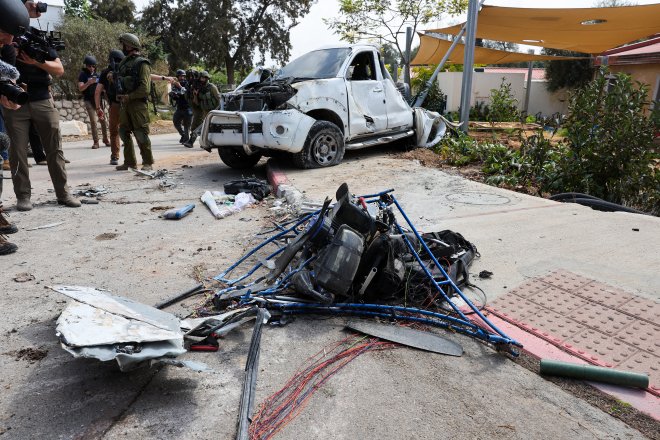US searches for remains of suspected spy balloon
An operation is underway to recover the debris of the suspected Chinese spy balloon shot down by the U.S. Air Force as Beijing warns against escalation and threatens retaliation.
“Multiple” naval vessels with divers have been deployed while a salvage ship is on its way to the recovery site off the South Carolina coast, U.S. defense officials told reporters at a Pentagon briefing Saturday.
The FBI, under the counter-intelligence authorities, is also taking part in the process, the officials said.
Meanwhile, Chinese officials said they “strongly protest against the U.S."s use of force to attack the civilian unmanned airship” that has “seriously impacted and damaged both sides" efforts and progress in stabilizing Sino-U.S. relations.”
Vice minister of foreign affairs Xie Feng on Monday lodged a “solemn presentation” to the U.S. embassy in Beijing and urged the U.S. “not to take further actions that harm China"s interests, and not to escalate or expand the tension.”
![]() Newspapers in the Chinatown district of Los Angeles on Sunday, Feb. 5, 2023. Credit: AP Photo/Damian Dovarganes
Newspapers in the Chinatown district of Los Angeles on Sunday, Feb. 5, 2023. Credit: AP Photo/Damian Dovarganes
China insisted the balloon was a civilian meteorological airship that strayed into the U.S. airspace due to “force majeure”, or unforeseeable circumstances and accused Washington of “overreacting.”
U.S. officials said they’re confident it was a surveillance balloon.
“It was an overreaction if it was only a weather balloon. But if it proves to be something more than that, there appears to be some justification for a fairly stern response,” said John Blaxland, professor of International Security and Intelligence Studies at the Australian National University (ANU).
“We should have some further insights when the pieces are recovered,” Blaxland said.
“While President Xi Jinping has backed away from the wolf warrior diplomacy in recent months, substantively China’s actions remain as assertive as ever and the balloon incident suggests that continues,” the Canberra-based professor added.
Recovery process
U.S. officials first detected the balloon on Jan. 28, when it entered U.S. airspace near the Aleutian Islands.
It was shot down by an F-22 Raptor fighter using a single AIM-9X Sidewinder missile at 2:39 p.m. on Saturday afternoon. The debris was spread over seven miles (11.2 kilometers) and in 47 feet (14.2 meters) of water.
The recovery is anticipated as “fairly easy,” a senior military official said, and could be done in days, rather than weeks or months.
The U.S. Navy has deployed the destroyer USS Oscar Austin, the cruiser USS Philippine Sea and the USS Carter Hall, an amphibious landing ship, in support of the strike.
Data obtained by RFA from the ship-tracking website MarineTraffic show that as of Monday morning the USS Oscar Austin is heading northwards, suggesting the initial search has been done and mission participants “are waiting for the salvage vessel to do a more thorough search and recovery” when it arrives, said Carl Schuster, former director of operations at the U.S. Pacific Command"s Joint Intelligence Center.
U.S. defense officials said a U.S. Navy salvage ship has been dispatched and would be on-scene “within a couple of days.”
“The salvage vessel will have equipment on it to ensure the recovered material is preserved,” said Schuster.
The retired U.S. Navy captain warned that the search area may be larger than expected as “the waters off South Carolina have strong currents and a soft, sandy bottom so the smaller pieces will be moved or covered.”
“But salvage vessels have the capability to calculate that drift, find and recover the material.”
“Once confident they have recovered everything, they will take it somewhere, probably Norfolk or Dahlgren, to reassemble and analyze it,” Schuster said.
At the briefing on Saturday, a senior U.S. defense official said the Pentagon “will seek to recover all debris and any material of intelligence value, as well as to work closely with the FBI “on the chain of custody.”
Not the first incident
The defense official added that “the surveillance balloon"s overflight of U.S. territory was of intelligence value to us ... we were able to study and scrutinize the balloon and its equipment, which has been valuable.”
“This surveillance balloon purposefully traversed the United States and Canada. And we are confident it was seeking to monitor sensitive military sites,” he said.
There were three Chinese surveillance balloons operating in the Western Hemisphere at the same time, the official said.
“These balloons are all part of a PRC fleet of balloons developed to conduct surveillance operations, which have also violated the sovereignty of other countries,” he said, referring to China by its official name the People’s Republic of China.
Chinese balloons also briefly transited the continental United States at least three times during the Trump administration, the official added.
“I suspect other such encounters may emerge, but Xi has to be careful,” said Professor John Blaxland at ANU.
“China still needs a relatively cooperative United States and further aggravation will make U.S. concessions all the more difficult politically for Biden,” he said.
![]() U.S. Secretary of State Antony Blinken speaks at a joint news conference at the State Department in Washington, U.S. on Feb. 3, 2023. Credit: Reuters/Jonathan Ernst
U.S. Secretary of State Antony Blinken speaks at a joint news conference at the State Department in Washington, U.S. on Feb. 3, 2023. Credit: Reuters/Jonathan Ernst
The incident led to State Secretary Antony Blinken canceling his planned trip to Beijing last Friday.
“Post-balloon ordeal, it’s hard to imagine the Biden admin rescheduling Blinken’s visit to China anytime soon,” wrote Derek Grossman, a security and Indo-Pacific analyst at Rand Corporation, a policy think tank.
“And any talk of maintaining ‘guard rails’ in the relationship to prevent competition from spiraling out of control seems unthinkable now,” Grossman wrote on Twitter.
The analyst argued that the U.S. response to the incident that he called “our hysteria” has diminished the chance of a thaw in the bilateral relations.
“Shooting down a Chinese balloon over U.S. airspace is an excessive reaction that may escalate tensions with China and invite diplomatic or other retaliation,” said Andy Mok, a senior research fellow at the Center for China and Globalization in Beijing.
“It is crucial for nations to act with restraint and avoid any actions that could cause unintended consequences,” Mok told RFA.
[圖擷取自網路,如有疑問請私訊]
“Multiple” naval vessels with divers have been deployed while a salvage ship is on its way to the recovery site off the South Carolina coast, U.S. defense officials told reporters at a Pentagon briefing Saturday.
The FBI, under the counter-intelligence authorities, is also taking part in the process, the officials said.
Meanwhile, Chinese officials said they “strongly protest against the U.S."s use of force to attack the civilian unmanned airship” that has “seriously impacted and damaged both sides" efforts and progress in stabilizing Sino-U.S. relations.”
Vice minister of foreign affairs Xie Feng on Monday lodged a “solemn presentation” to the U.S. embassy in Beijing and urged the U.S. “not to take further actions that harm China"s interests, and not to escalate or expand the tension.”
 Newspapers in the Chinatown district of Los Angeles on Sunday, Feb. 5, 2023. Credit: AP Photo/Damian Dovarganes
Newspapers in the Chinatown district of Los Angeles on Sunday, Feb. 5, 2023. Credit: AP Photo/Damian DovarganesChina insisted the balloon was a civilian meteorological airship that strayed into the U.S. airspace due to “force majeure”, or unforeseeable circumstances and accused Washington of “overreacting.”
U.S. officials said they’re confident it was a surveillance balloon.
“It was an overreaction if it was only a weather balloon. But if it proves to be something more than that, there appears to be some justification for a fairly stern response,” said John Blaxland, professor of International Security and Intelligence Studies at the Australian National University (ANU).
“We should have some further insights when the pieces are recovered,” Blaxland said.
“While President Xi Jinping has backed away from the wolf warrior diplomacy in recent months, substantively China’s actions remain as assertive as ever and the balloon incident suggests that continues,” the Canberra-based professor added.
Recovery process
U.S. officials first detected the balloon on Jan. 28, when it entered U.S. airspace near the Aleutian Islands.
It was shot down by an F-22 Raptor fighter using a single AIM-9X Sidewinder missile at 2:39 p.m. on Saturday afternoon. The debris was spread over seven miles (11.2 kilometers) and in 47 feet (14.2 meters) of water.
The recovery is anticipated as “fairly easy,” a senior military official said, and could be done in days, rather than weeks or months.
The U.S. Navy has deployed the destroyer USS Oscar Austin, the cruiser USS Philippine Sea and the USS Carter Hall, an amphibious landing ship, in support of the strike.
Data obtained by RFA from the ship-tracking website MarineTraffic show that as of Monday morning the USS Oscar Austin is heading northwards, suggesting the initial search has been done and mission participants “are waiting for the salvage vessel to do a more thorough search and recovery” when it arrives, said Carl Schuster, former director of operations at the U.S. Pacific Command"s Joint Intelligence Center.
U.S. defense officials said a U.S. Navy salvage ship has been dispatched and would be on-scene “within a couple of days.”
“The salvage vessel will have equipment on it to ensure the recovered material is preserved,” said Schuster.
The retired U.S. Navy captain warned that the search area may be larger than expected as “the waters off South Carolina have strong currents and a soft, sandy bottom so the smaller pieces will be moved or covered.”
“But salvage vessels have the capability to calculate that drift, find and recover the material.”
“Once confident they have recovered everything, they will take it somewhere, probably Norfolk or Dahlgren, to reassemble and analyze it,” Schuster said.
At the briefing on Saturday, a senior U.S. defense official said the Pentagon “will seek to recover all debris and any material of intelligence value, as well as to work closely with the FBI “on the chain of custody.”
Not the first incident
The defense official added that “the surveillance balloon"s overflight of U.S. territory was of intelligence value to us ... we were able to study and scrutinize the balloon and its equipment, which has been valuable.”
“This surveillance balloon purposefully traversed the United States and Canada. And we are confident it was seeking to monitor sensitive military sites,” he said.
There were three Chinese surveillance balloons operating in the Western Hemisphere at the same time, the official said.
“These balloons are all part of a PRC fleet of balloons developed to conduct surveillance operations, which have also violated the sovereignty of other countries,” he said, referring to China by its official name the People’s Republic of China.
Chinese balloons also briefly transited the continental United States at least three times during the Trump administration, the official added.
“I suspect other such encounters may emerge, but Xi has to be careful,” said Professor John Blaxland at ANU.
“China still needs a relatively cooperative United States and further aggravation will make U.S. concessions all the more difficult politically for Biden,” he said.
 U.S. Secretary of State Antony Blinken speaks at a joint news conference at the State Department in Washington, U.S. on Feb. 3, 2023. Credit: Reuters/Jonathan Ernst
U.S. Secretary of State Antony Blinken speaks at a joint news conference at the State Department in Washington, U.S. on Feb. 3, 2023. Credit: Reuters/Jonathan ErnstThe incident led to State Secretary Antony Blinken canceling his planned trip to Beijing last Friday.
“Post-balloon ordeal, it’s hard to imagine the Biden admin rescheduling Blinken’s visit to China anytime soon,” wrote Derek Grossman, a security and Indo-Pacific analyst at Rand Corporation, a policy think tank.
“And any talk of maintaining ‘guard rails’ in the relationship to prevent competition from spiraling out of control seems unthinkable now,” Grossman wrote on Twitter.
The analyst argued that the U.S. response to the incident that he called “our hysteria” has diminished the chance of a thaw in the bilateral relations.
“Shooting down a Chinese balloon over U.S. airspace is an excessive reaction that may escalate tensions with China and invite diplomatic or other retaliation,” said Andy Mok, a senior research fellow at the Center for China and Globalization in Beijing.
“It is crucial for nations to act with restraint and avoid any actions that could cause unintended consequences,” Mok told RFA.
[圖擷取自網路,如有疑問請私訊]
|
本篇 |
不想錯過? 請追蹤FB專頁! |
| 喜歡這篇嗎?快分享吧! |
相關文章
AsianNewsCast

















